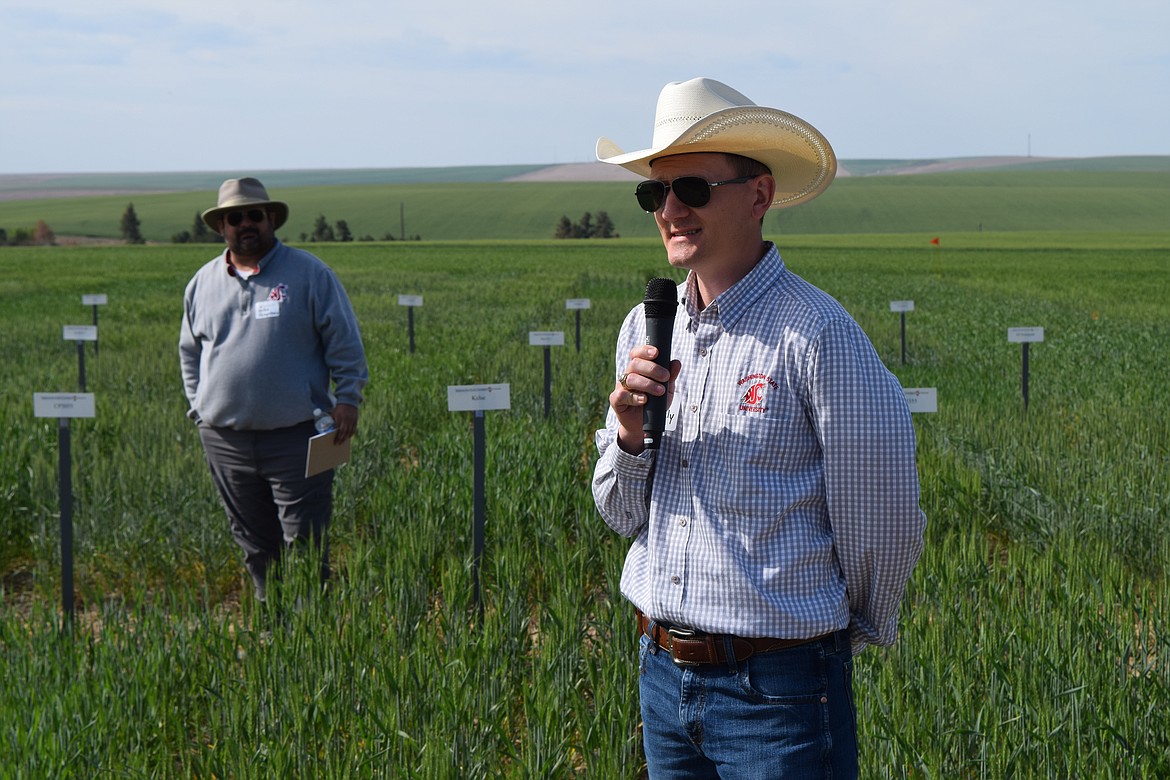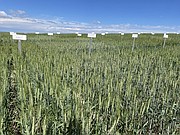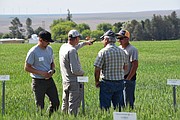Field day returns to WSU wheat farm
LIND — Washington State University wheat researcher Mike Pumphrey said that after last year’s drought and heat wave, he simply did not expect it to rain as much as it has this year.
“How much rain did you guys know we were going to get from about the 10th of March until now?” he asked. “You planned on wind. Did anybody plan on a bunch of rain?”
As he spoke, Pumphrey stood in the midst of a bunch of five-by-eight-foot test plots of spring wheat, all planted at WSU’s Dryland Research Station in Lind, surrounded by a group of farmers and other researchers. Pumphrey himself said he planned for another very dry year in 2022 and planted his wheat trials for the year near St. John, to guarantee he could get some rain.
According to its website, the Dryland Research Station received nearly three inches of rain so far this year from March 1 through the end of May, compared with a scant half-inch all spring and summer in 2021.
They all gathered on Thursday, June 16, at the station northeast of Lind for the station’s 2022 field day to review some of the latest trials of wheat varieties tailored for sprawling, dryland wheat farms of Adams, Lincoln and Franklin counties, as well to examine tests of oilseed rotation crops, learn about wheat diseases currently affecting the region, and get a look at a sensor-equipped sprayer designed to much more efficiently use herbicides to control weeds.
Because of the COVID-19 pandemic, it’s the first time in two years that WSU has hosted the field day tour at the station, according to Drew Lyon, WSU’s interim chair of the Department of Crop and Sciences.
“I would say this is our premier field day at Washington State University. And not being able to do it for two years was really kind of a bummer. So it's really nice to get back,” Lyon said.
The only other time in the station’s 107-year-history the field day visit was canceled was in 1980 following the eruption of Mount St. Helens.
Leonard Van Buren, a farmer and rancher near Kahlotus in Franklin County and president of the Franklin County Wheat Growers, said he came to the event this year to get some ideas for his farm as he prepares to take some of his land out of the U.S. Department of Agriculture’s Conservation Reserve Program.
“It’s going to be going back into wheat production and what have you, so we’re trying to figure out what maybe some of our options are, what we might be looking forward to in the next couple of years,” Van Buren said.
Researchers told tour participants that while this year’s rain was more than ample, the 10-12 degrees cooler-than-normal temperatures had put wheat development and maturation back about two weeks, and the wet and cold were providing opportunities for some wheat diseases that don’t normally plague dryland wheat fields in Central Washington.
“The good news is that we have resistance in a lot of the varieties that are adapted to the PNW,” said WSU plant pathologist Tim Murray about soil-borne wheat mosaic virus, which has been found in some wheat fields north of U.S. Highway 2. “We've known about this disease in the United States for over 100 years. Most of the Great Plains, the Midwest and the east, have dealt with this disease for a long time. There's a lot of efforts for breeding for resistance to this disease.”
Most researchers making presentations during the tour said they also delayed planting last year because of the drought, and that means the winter wheat isn’t going to provide the yields it normally would.
Pumphrey, however, told farmers that despite the two odd years — last year’s drought and this year’s cooler and wetter weather — researchers still have to consider the average climate in the various regions of Eastern Washington, that the dryland farms of the Columbia Basin are always going to get less rain than the Palouse, and wheat breeders need to account for that.
“The justification for the past few years is heat and drought tolerance,” he said. “Any time you show up to a testing site … any time you look at anybody’s data, you need to think about years, about broad adaptation and stability.”
Charles H. Featherstone can be reached at cfeatherstone@columbiabasinherald.com.







